J. R. R. Tolkien
|
The True Meaning of High Fantasy: A Yearning for the Undying Lands  (photos of J. R. R. Tolkien in 1911 and his beloved wife Edith) Wiki entry, ISFDB entry, scroll down reviews and ratings: "The Adventures of Tom Bombadil" (Middle-Earth) © The Oxford Magazine, 1934 The Chronicle of the Convent of the Sacred Heart, 1934 book: Allen & Unwin, 1962 --/ fourth place f novel --/ wonder award ---------------------------------------------- 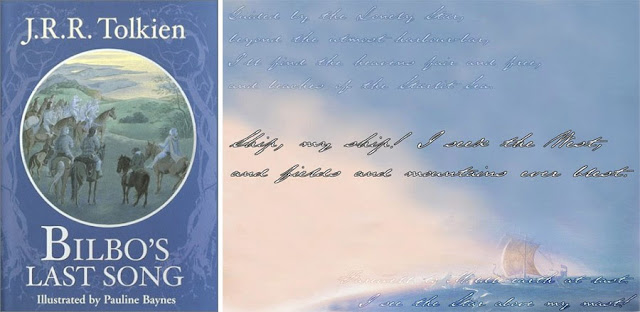 "Bilbo's Last Song (At the Grey Havens)" (Middle-Earth) © 1946, original book: Allen & Unwin, 1974 --/ style award --/ wonder award A poem written by Bilbo Baggins just before he boards a ship from Middle-earth to the Undying Lands at the end of The Lord of the Rings. Very stirring, in the elegaic mood, full of riveting imagery. Something that will make you cry and your heart sing. The poetry itself perhaps is not as important as the thoughts conveyed here - everyone can listen to the music of these thoughts. A perfect piece for a genius composer. ----------------------------------------------  "The Book of Lost Tales. Parts I & II" (coll) (Middle-Earth: history 2 & 3) © poems written in 1914-1918 book: Allen & Unwin, 1983-1984 --fantasy : 1985 Mythopoeic --/ third place f collection --/ wonder award --/ style award When the Middle-earth Trilogy and "Silmarillion" are just not enough... It was surprising to learn that a significant part of the Middle-Earth history, and a general feel and atmosphere of the Tolkien's world (including most poignant of his poems) - all were completed between 1914 to 1920, at the time when Tolkien was in love and when he experienced the terrors of war - but then, this is not really surprising, is it? I think that it is only proper - considering the intensity of feeling, freshness of emotion, vast scale of vistas and romanticism of the highest order that went into that "world-that-never-was-and always-is", the Middle-Earth. The true scale of Tolkien's mythology and its poetic qualities can only be appreciated outside the confines of a single trilogy (and definitely outside of Peter Jackson's movies, which seem to emphasize dark aspects of Middle-earth rather than its beautiful High Elves side). So, go ahead and get hooked on exploring in depth the epic history and the mysterious knowledge in the "Silmarillion" and the "Books of Lost Tales"; after all, this is how Middle-earth was originally intended to be experienced - better than in 3-D. The "Return of the King and the Downfall of the Lord of the Rings" trilogy (that being the original and proper title of "The Lord of the Rings") should be regarded as only the front-piece, the gate, the first step into... as big a world as human imagination can contain, or put on paper. In Tolkien's life, love became a catalyst to imagining and realizing monumental works, and love can only grow with time. 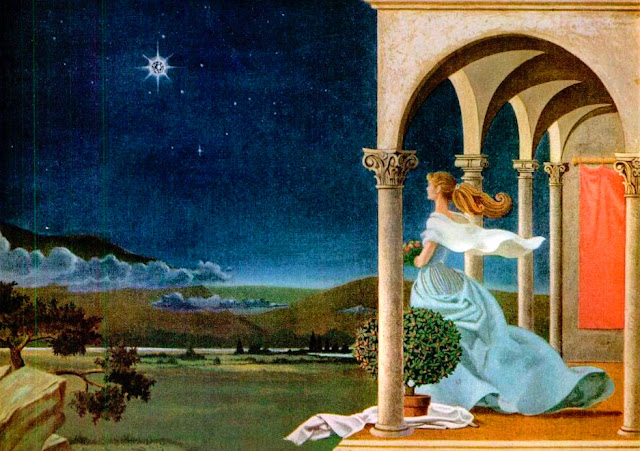 (illustration credit: Life magazine, 1951) ---------------------------------------------- "The Fellowship Of The Ring" (nv) (Lord Of The Rings 1) (Middle-Earth) © written 1937-1947 book: Allen & Unwin, 1954 --fiction : 1957 International Fantasy W --all-time series : 1966 Hugo --all time novel : 1975 Locus All-Time Poll /15 --all time fantasy novel : 1987 Locus All-Time Poll W --fantasy novel (before 1990) : 1998 Locus All-Time Poll W --hall of fame : 2002 Prometheus --/ FIRST place f novel --/ wonder award --/ awesome scale --/ idea award --/ adventure award --/ style award --/ romance award --/ humor award --/ emotion award "The Return of the King and the Downfall of the Lord of the Rings" (also known as "The Red Book of Westmarch")... even better known as "The Hobbit" and "The Lord of the Rings": The early drafts and poems for that book appeared in 1915, providing the first glimpses into Tolkien's magical country of the Shire. Some epic poems and individual chapters of the "Silmarillion" took shape even earlier, so we can safely say that Tolkien was already "hooked" on Middle-Earth and adventures wherein way back in the 1910s, even though "The Hobbit" was not written down until 1935. (What's even more intriguing, Tolkien wanted to create a full-scale mythology for England itself - he felt that the English language lacked a really exciting set of myths, compared to other languages - a magical environment for other writers to explore and play in... Which is exactly what happened, if we look at the amount of epic fantasy stories set in Middle-earth during the last few decades). ---------------------------------------------- "The Happy Mariners" © The Stapeldon Magazine, 1920 The Book Of Lost Tales 2, 1984 --/ fourth place f story --/ wonder award ---------------------------------------------- 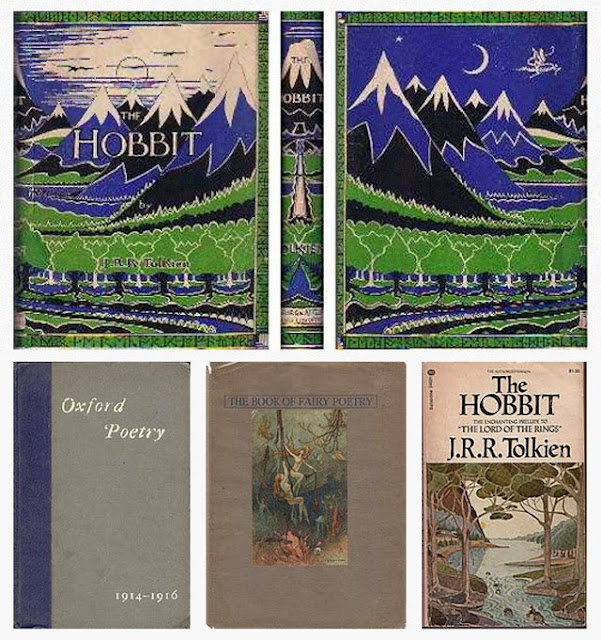 "The Hobbit, or, There and Back Again" (nv) (Lord Of The Rings) (Middle-Earth) © 1937, Allen & Unwin poems also in - Oxford Poetry, 1915 Leeds University Verse, 1924 book: Allen & Unwin, 1937 --all time fantasy novel : 1987 Locus All-Time Poll /2 --fantasy novel (before 1990) : 1998 Locus All-Time Poll /2 --/ third place f novel --/ wonder award --/ idea award --/ adventure award --/ style award Much has been written about The Hobbit, from the influence of World War 1 on Tolkien's creation and development of Middle Earth, to literary and stylistic reviews. What is there left for one to say about this, the most charming of Tolkien's works and probably the entire genre? Though it was written for children, it appeals to the "Tookishness" in everyone: that deep down desire for more than just a comfortable hobbit hole - for adventure, and legends of long ago to wake up and invade breakfast. Who wouldn't want to be whisked away without even a handkerchief on some wild adventure? The storyline is not without its faults and a tendency towards "Deus Ex Machina" solutions, but they are carried off with such unapologetic aplomb that one cannot help enjoying every image and word. Tolkien's treatment of human emotion and motivation - filtered through his hobbit and dwarves - is without fault and honest: courage, greed, pride, resourcefulness, wit, humor, despair, love, loyalty and duty are all met and measured. Bilbo, who is so comfortable in his hobbit life that his neighbors don't even have to ask him what his opinions are, finds himself the odd one out among a pack of dwarves and with the awful label of burglar. He "lives up" to this challenge in ways which show his true character and surprises everyone. This book is truly one to curl up with on a February evening when it seems life has dulled into a cramped, damp hobbit-hole... it's always helpful to remember, you could be stuffed in a barrel and dumped in a river. (review by Rachel Abrams, Dark Roasted Blend) 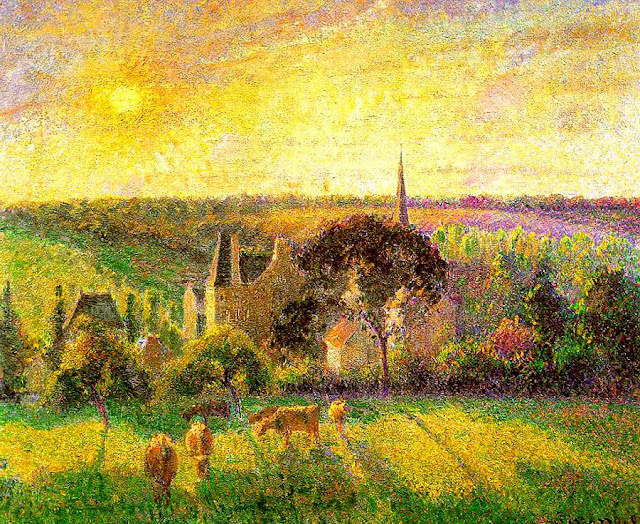 (Not exactly the Shire from "The Hobbit", but this 1873 painting by Caille Pissaro nevertheless has that sparkling and innocent feel...) ---------------------------------------------- "The Lay of Leithian" (Middle-Earth) © written 1937 The Lays of Beleriand, 1985 --/ FIRST place fantasy story --/ awesome scale --/ wonder award --/ adventure award --/ style award --/ romance award --/ emotion award --/ shock value ---------------------------------------------- 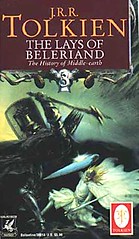 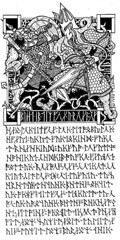 "The Lays of Beleriand" (coll) (Middle-Earth: history 4) © Allen & Unwin, 1986 --/ FIRST place f collection --/ awesome scale --/ wonder award --/ idea award --/ adventure award --/ style award --/ romance award --/ emotion award --/ shock value No words necessary. For those who loves "high fantasy" there could no better catalyst to imagination than these epic poems, in every line of which we find LIFE, DEATH, LOVE concentrated. Closest thing to the Bible (I mean the whole Middle-Earth series) For sheer intensity of legends, implied beauty and depths of destruction, this is it. 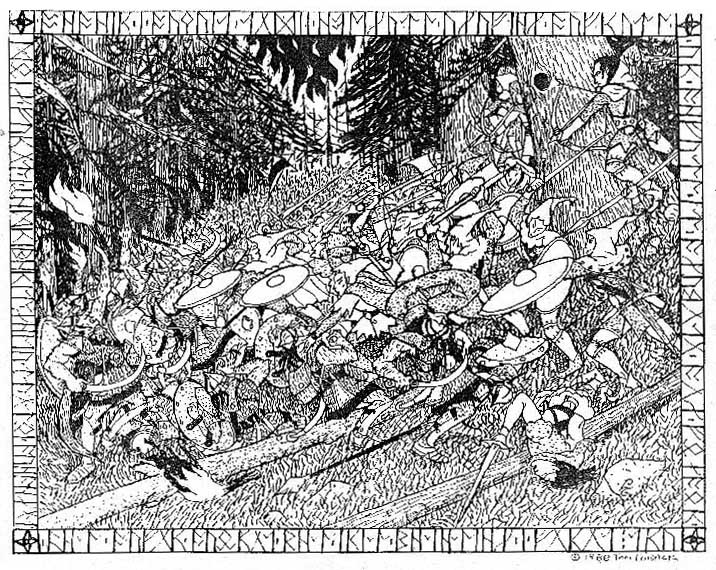 ---------------------------------------------- "Leaf by Niggle" © Dublin Review, Jan 1945 Tree And Leaf, 1964 Rovesnik, 1983 --/ cool f story --/ wonder award "Light as Leaf on Lindentree" (Middle-Earth) © The Gryphon, Jun 1925 The Lays of Beleriand, 1985 --/ cool f story --/ wonder award "Mythopoeia" (nf) © 1939, original "Return Of The King" (nv) (Lord Of The Rings 3) (Middle-Earth) © written 1937-1954 book: Allen & Unwin, 1955 --fiction : 1957 International Fantasy W --all-time series : 1966 Hugo --all time novel : 1975 Locus All-Time Poll /15 --all time fantasy novel : 1987 Locus All-Time Poll W --fantasy novel (before 1990) : 1998 Locus All-Time Poll W --hall of fame : 2002 Prometheus --/ FIRST place f novel --/ wonder award --/ awesome scale --/ idea award --/ adventure award --/ style award --/ romance award --/ humor award --/ emotion award --/ shock value "The Shaping of Middle-earth" (coll) (The Quenta, the Ambarkanta, and the Annals) (Middle-Earth: history 5) © Allen & Unwin, 1987 --/ second place f collection --/ awesome scale --/ wonder award --/ idea award --/ adventure award --/ style award "The Silmarillion" (nv) (Lord Of The Rings) (Middle-Earth) © written 1925-1954 book: Allen & Unwin, 1977 --fantasy novel : 1978 Locus W --international fiction : 1978 Ditmar W --book-length fantasy : 1978 Gandalf W --/ FIRST place f collection --/ awesome scale --/ wonder award --/ idea award --/ adventure award --/ style award --/ romance award --/ humor award --/ emotion award --/ shock value ---------------------------------------------- "Smith of Wootton Major" (also as "The Great Cake") (Middle-Earth, possibly) © 1967, Allen & Unwin (illustrated by Pauline Baynes) --/ second place f novella --/ wonder award --/ adventure award --/ idea award --/ style award --/ emotion award The village of Wootton Major was well-known around the countryside for its annual festivals, which were particularly famous for their culinary delights. The biggest festival of all was the Feast of Good Children. This festival was celebrated only once every twenty-four years: twenty-four children of the village were invited to a party, and the highlight of the party was the Great Cake, a career milestone by which Master Cooks were judged. In the year the story begins, the Master Cook was Nokes, who had landed the position more or less by default; he delegated much of the creative work to his apprentice Alf. Nokes crowned his Great Cake with a little doll jokingly representing the Queen of Faery. Various trinkets were hidden in the cake for the children to find; one of these was a star the Cook discovered in the old spice box. The star was not found at the Feast, but was swallowed by a blacksmith’s son. The boy did not feel its magical properties at once, but on the morning of his tenth birthday the star fixed itself on his forehead, and became his passport to Faery. The boy grew up to be a blacksmith like his father, but in his free time he roamed the Land of Faery. The star on his forehead protected him from many of the dangers threatening mortals in that land, and the Folk of Faery called him "Starbrow". The book describes his many travels in Faery, until at last he meets the true Queen of Faery. The identity of the King is also revealed. The time came for another Feast of Good Children. Smith had possessed his gift for most of his life, and the time had come to pass it on to some other child. So he regretfully surrendered the star to Alf, and with it his adventures into Faery. Alf, who had become Master Cook long before, baked it into the festive cake once again for another child to find. After the feast, Alf retired and left the village; and Smith returned to his forge to teach his craft to his now-grown son. Read review by John Garth here ---------------------------------------------- "Tree And Leaf: Esse" (nf) © 1939, Dublin Review "The Two Towers" (nv) (Lord Of The Rings 2) (Middle-Earth) © written 1937-1947 book: Allen & Unwin, 1954 --fiction : 1957 International Fantasy W --all-time series : 1966 Hugo --all time novel : 1975 Locus All-Time Poll /15 --all time fantasy novel : 1987 Locus All-Time Poll W --fantasy novel (before 1990) : 1998 Locus All-Time Poll W --hall of fame : 2002 Prometheus --/ FIRST place f novel --/ wonder award --/ awesome scale --/ idea award --/ adventure award --/ style award --/ romance award --/ humor award --/ emotion award --/ shock value "Unfinished Tales of Numenor and of Middle-earth" (coll) (Middle-Earth: history 1) © Allen & Unwin, 1978 --single author collection : 1981 Locus /13 --fantasy : 1981 Mythopoeic W --collection/anthology : 1981 Balrog W --/ second place f collection --/ awesome scale --/ wonder award --/ idea award --/ adventure award --/ style award  (left: "Spring Sleep" by sis; right images: "Monastery Graveyard In The Snow" and "Watzmann" by Caspar David Friedrich, via) |
Click to go to "Dark Roasted Blend" site
|
|
Collecting Pulp Magazines Ephemera Interview with Avi Abrams |

|
Enchanting Victorian Fairy Tale Art "Then world behind and home ahead..." |

|
Exceptional British Scifi Artwork from the 1950s Space Pulp Art by Ron Turner and other British artists |
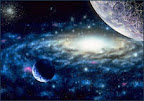
|
Pulp Pleasures: Eando Binder Great space adventure fiction from the 1930s "Where Eternity Ends" and other rare gems |
Also read recent posts:
Author's Pen Names - Most Complete List Ever
The Wonder Timeline: SF&F Restrospective
Space Adventure Article
|
"SF&F Reading Experience" is part of "Dark Roasted Blend / Thrilling Wonder" family of sites. We try to highlight the most entertaining and rewarding science fiction and fantasy, with emphasis on memorable reader experience, not necessarily general acceptance by the critics. Have fun, and delve into our extensive ratings and reviews! Most reviews are written by Avi Abrams, unless otherwise noted. Reviews also appear on our unique historical retrospective page Wonder Timeline of Science Fiction. Feel free to submit your own review, if a particular story is not listed here. All major OFFICIAL AWARDS are highlighted in BLUE ("winner" has a letter "W" by it, otherwise it is a runner-up only) Our PERSONAL AWARDS (ratings) are highlighted in RED and PURPLE: --/ first place : --/ second place : --/ third place : --/ fourth place : --/ cool : (equal to fifth place) ALL "BEST OF" LISTS ARE LOCATED HERE These awards are given in the following categories: - novel : - series : - novella : - story : - collection : Also, there are our personal STYLE / GENRE SPECIFIC AWARDS. These reflect the story's content and the lasting impression on the reader: --/ wonder award sense-of-wonder, "visual intensity" and inventiveness --/ idea award originality of idea / concept --/ adventure award exhilarating plot, excitement / action --/ style award outstanding literary qualities, inimitable style --/ romance award intense and beautiful love / relationships --/ humour award funny and cool --/ emotion award touching, lasting impression, sensitivity --/ shock value altogether wild --/ awesome scale mind-boggling; further enhances sense-of-wonder --/ rare find very hard to locate, mostly from old pulps, never reprinted, etc. Again, please feel free to leave your own review or comment under every writer's entry; also recommend us other stories you liked. |
0 Comments:
Post a Comment
<< Home